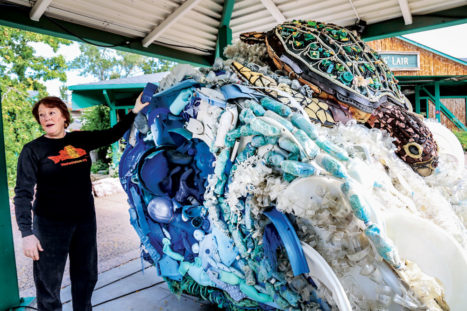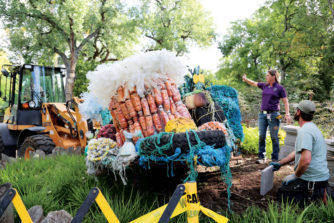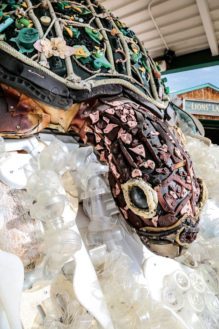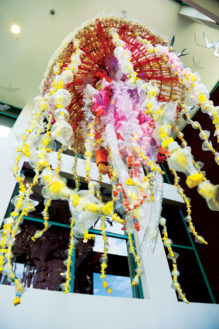
Artist Angela Haseltine Pozzi points to “Flash,” the marlin created from flotsam, including fishing poles, fishing lures, Hello Kitty flip-flops, and Tonka truck tires.
Widowed at the age of 47, artist and teacher Angela Haseltine Pozzi sought refuge and healing on the southern Oregon coast at an old family cabin. As she walked the beach reflecting upon her purpose in life, she kept trying to ignore the vast quantities of plastic strewn on the shore. During one walk, however, at the high-water mark, “as far as the eye could see, it was a mosaic of plastic. A mile out. I was sick to my stomach, and I thought, how is it possible that we are destroying this?” she says. But at that moment, her purpose became clear.
Washed Ashore from Anne Hebert on Vimeo.
With her experience as an artist and an educator, Pozzi not only saw the potential to make art with the plastic debris but also had the ability to bring together groups of people to join her in her efforts. She founded a nonprofit organization, Washed Ashore, to raise awareness of ocean pollution through community-built art.

Pozzi is shown with “Natasha” the sea turtle who is riding a wave of plastic bags that look like seafoam in the sculpture.
From her workshop in Bandon, OR, Pozzi now leads teams of volunteers in constructing elaborate sculptures made entirely from objects that have been scavenged from beaches, and the project has processed more than 20 tons of material into over 70 sculptures.

Pozzi adjusts plastic bags on the “Anemone Garden” sculpture as it is being installed.
Denver Zoo is the first major inland, non-coastal zoo to host an exhibit of this work, entitled “Washed Ashore: Art to Save the Sea.” On display from Saturday, Sept. 24 through Jan. 16, 2017, the 15 sea life sculptures are spread throughout the zoo. They are vivid, detailed works of art, highly crafted without the use of any additional colorants or plastic materials, and each one has a name and a story. Displays will feature information and interactive features, such as scavenger hunts where viewers are challenged to find unusual construction materials, like flip-flops, rubber boots, or lighters.
Since nearly 80 percent of the plastic waste found in the oceans originates on land, “inland populations need to realize that they’re a vital part of this issue,” says Pozzi. She and her team constructed a chinook salmon sculpture (“Nora”) on-site in Denver to draw attention to the freshwater connection to ocean pollution, which comes “from rivers, from gutters and streams, from creeks to oceans,” she notes. In fact, the works feature hundreds of plastic water bottles branded from the 2008 Beijing Olympics, which continue to wash up on the West Coast eight years later. “Nora” will be on display near the river otter exhibit to raise awareness of the watershed connection.

The tiger shark, “Chompers,” weighs 850 pounds and is displayed at Toyota Elephant Passages Sycamore Island.
The zoo hopes to teach young guests “to love and value animals that live in the ocean,” says Brad Parks, the senior director of guest experience. “Every kid in Denver should be able to come here and get excited about sea turtles and realize that some of the plastic bags and plastic bottles that get away from us can actually harm those animals. What can we do to recycle, to make sure we’re good environmental stewards? What can we do to help take care of nature?”

The yellow sea jelly, displayed on the Gates Center west entrance ceiling, is 10 feet tall, 6 feet in diameter, and weighs 350 pounds.
Many families will also be excited to find the sculptures integrated into the holiday Zoo Lights tradition.
For school groups, the zoo will have a self-guided field trip that teachers will be able to download from the zoo website so they can bring their classes and tour the zoo. Learning will come from observation and interaction: “Angela wants people to touch the sculptures, to get close to them. She wants to really have people recognize that what that’s made of is a plastic bottle that could have been yours or mine,” says Parks. Pozzi is also developing an art education curriculum in conjunction with the National Oceanic and Atmospheric Administration (NOAA) that will be available in January 2017. Through her artwork, she hopes to teach visitors, old and young alike, that “everybody’s small actions come together to make a big difference.”
For more information, visit www.denverzoo.org



0 Comments